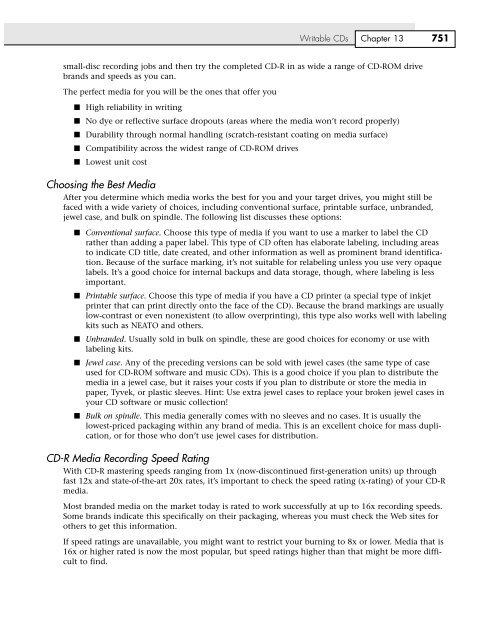Create successful ePaper yourself
Turn your PDF publications into a flip-book with our unique Google optimized e-Paper software.
Writable CDs Chapter <strong>13</strong><br />
751<br />
small-disc recording jobs and then try the completed CD-R in as wide a range of CD-ROM drive<br />
brands and speeds as you can.<br />
The perfect media for you will be the ones that offer you<br />
■ High reliability in writing<br />
■ No dye or reflective surface dropouts (areas where the media won’t record properly)<br />
■ Durability through normal handling (scratch-resistant coating on media surface)<br />
■ Compatibility across the widest range of CD-ROM drives<br />
■ Lowest unit cost<br />
Choosing the Best Media<br />
After you determine which media works the best for you and your target drives, you might still be<br />
faced with a wide variety of choices, including conventional surface, printable surface, unbranded,<br />
jewel case, and bulk on spindle. The following list discusses these options:<br />
■ Conventional surface. Choose this type of media if you want to use a marker to label the CD<br />
rather than adding a paper label. This type of CD often has elaborate labeling, including areas<br />
to indicate CD title, date created, and other information as well as prominent brand identification.<br />
Because of the surface marking, it’s not suitable for relabeling unless you use very opaque<br />
labels. It’s a good choice for internal backups and data storage, though, where labeling is less<br />
important.<br />
■ Printable surface. Choose this type of media if you have a CD printer (a special type of inkjet<br />
printer that can print directly onto the face of the CD). Because the brand markings are usually<br />
low-contrast or even nonexistent (to allow overprinting), this type also works well with labeling<br />
kits such as NEATO and others.<br />
■ Unbranded. Usually sold in bulk on spindle, these are good choices for economy or use with<br />
labeling kits.<br />
■ Jewel case. Any of the preceding versions can be sold with jewel cases (the same type of case<br />
used for CD-ROM software and music CDs). This is a good choice if you plan to distribute the<br />
media in a jewel case, but it raises your costs if you plan to distribute or store the media in<br />
paper, Tyvek, or plastic sleeves. Hint: Use extra jewel cases to replace your broken jewel cases in<br />
your CD software or music collection!<br />
■ Bulk on spindle. This media generally comes with no sleeves and no cases. It is usually the<br />
lowest-priced packaging within any brand of media. This is an excellent choice for mass duplication,<br />
or for those who don’t use jewel cases for distribution.<br />
CD-R Media Recording Speed Rating<br />
With CD-R mastering speeds ranging from 1x (now-discontinued first-generation units) up through<br />
fast 12x and state-of-the-art 20x rates, it’s important to check the speed rating (x-rating) of your CD-R<br />
media.<br />
Most branded media on the market today is rated to work successfully at up to 16x recording speeds.<br />
Some brands indicate this specifically on their packaging, whereas you must check the Web sites for<br />
others to get this information.<br />
If speed ratings are unavailable, you might want to restrict your burning to 8x or lower. Media that is<br />
16x or higher rated is now the most popular, but speed ratings higher than that might be more difficult<br />
to find.
















